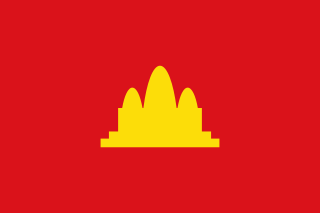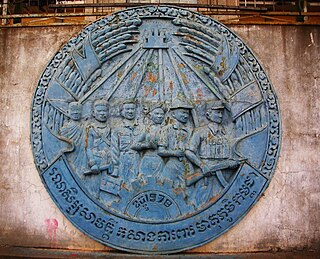
The Khmer Rouge is the name that was popularly given to members of the Communist Party of Kampuchea (CPK) and by extension to the Democratic Kampuchea through which the CPK ruled Cambodia between 1975 and 1979. The name was coined in the 1960s by Norodom Sihanouk to describe his country's heterogeneous, communist-led dissidents, with whom he allied after the 1970 Cambodian coup d'état.

Pol Pot was a Cambodian revolutionary, politician and dictator who ruled Cambodia as Prime Minister of Democratic Kampuchea between 1976 and 1979. Ideologically a Maoist and a Khmer ethnonationalist, Pot was a leader of Cambodia's Communist movement, known as the Khmer Rouge, from 1963 to 1997. He served as General Secretary of the Communist Party of Kampuchea from 1963 to 1981, during which Cambodia was converted into a one-party state. Between 1975 and 1979, Pot perpetrated the Cambodian genocide, in which an estimated 1.5–2 million people died—approximately one-quarter of the country's pre-genocide population. In December 1978, Vietnam invaded Cambodia to remove the Khmer Rouge from power. Within two weeks, Vietnamese forces occupied most of the country, ending the genocide and establishing a new Cambodian government, with the Khmer Rouge restricted to the rural hinterlands in the western part of the country.

Son Sen, alias Comrade Khieu (សមមិត្តខៀវ) or "Brother Number 89", was a Cambodian Communist politician and soldier. A member of the Central Committee of the Communist Party of Kampuchea/Party of Democratic Kampuchea, the Khmer Rouge, from 1974 to 1992, Sen oversaw the Party's security apparatus, including the Santebal secret police and the notorious security prison S-21 at Tuol Sleng.

Heng Samrin is a Cambodian politician who served as the President of the National Assembly of Cambodia (2006–2023). Between 1979 and 1992, he was the de facto leader of the Hanoi-backed People's Republic of Kampuchea (1979–1989) and State of Cambodia (1989–1992) and General Secretary of the Kampuchean People's Revolutionary Party (1981–1991). He has been a member of Parliament since 14 June 1993. He is the oldest member of parliament, and the longest-serving president of the National Assembly in history. His honorary title is "Samdech Akka Moha Ponhea Chakrei Heng Samrin".

Islam is the religion of a majority of the Cham and Malay minorities in Cambodia. According to activist Po Dharma, there were 150,000 to 200,000 Muslims in Cambodia as late as 1975, although this may have been an exaggeration. Persecution under the Khmer Rouge eroded their numbers, however, and by the late 1980s they probably had not regained their former strength. In 2009, the Pew Research Center estimated that 1.6% of the population, or 236,000 people were Muslims. In 2021, the State Department estimated the Islamic population at less than 1%. Like other Muslim Cham people, those in Cambodia are Sunni Muslims of the Shafi'i denomination and following the Maturidi doctrine. Po Dharma divides the Muslim Cham in Cambodia into a traditionalist branch and an orthodox branch.

The Cambodian–Vietnamese War was an armed conflict between Democratic Kampuchea, controlled by Pol Pot's Khmer Rouge, and the Socialist Republic of Vietnam. The war began with repeated attacks by the Kampuchea Revolutionary Army on the southwestern border of Vietnam, particularly the Ba Chúc massacre which resulted in the deaths of over 3,000 Vietnamese civilians. On 23 December 1978, 10 out of 19 of the Khmer Rouge's military divisions opened fire along the border with Vietnam with the goal of invading the Vietnamese provinces of Đồng Tháp, An Giang and Kiên Giang. On 25 December 1978, Vietnam launched a full-scale invasion of Kampuchea, occupying the country in two weeks and removing the government of the Communist Party of Kampuchea from power. In doing so, Vietnam put an ultimate stop to the Cambodian genocide, which had most likely killed between 1.2 million and 2.8 million people — or between 13 and 30 percent of the country’s population. On 7 January 1979, the Vietnamese captured Phnom Penh, which forced Pol Pot and the Khmer Rouge to retreat back into the jungle near the border with Thailand.

Nuon Chea, also known as Long Bunruot or Rungloet Laodi, was a Cambodian communist politician and revolutionary who was the chief ideologist of the Khmer Rouge. He also briefly served as acting Prime Minister of Democratic Kampuchea. He was commonly known as "Brother Number Two", as he was second-in-command to Khmer Rouge leader Pol Pot, General Secretary of the Party, during the Cambodian genocide of 1975–1979. In 2014, Nuon Chea received a life sentence for crimes against humanity, alongside another top-tier Khmer Rouge leader, Khieu Samphan, and a further trial convicted him of genocide in 2018. These life sentences were merged into a single life sentence by the Trial Chamber on 16 November 2018. He died while serving his sentence in 2019.
The Khmer Krom are ethnically Khmer people living in or from the Mekong Delta, the south western part of Vietnam known in Khmer as Kampuchea Krom. The Khmer Krom people are considered an the indigenous people of parts of Southern Vietnam and have the oldest extant recorded history of inhabiting in the region. In Vietnam, they are recognized as one of Vietnam's fifty-three ethnic minorities.
Benedict F. "Ben" Kiernan is an Australian-born American historian who is the Whitney Griswold Professor Emeritus of History, Professor of International and Area Studies and Director of the Genocide Studies Program at Yale University.

Democratic Kampuchea was the official name of the Cambodian state from 1976 to 1979, under the totalitarian dictatorship of Pol Pot and the Communist Party of Kampuchea (CPK), commonly known as the Khmer Rouge. The Khmer Rouge's capture of the capital Phnom Penh in 1975 effectively ended the United States-backed Khmer Republic of Lon Nol.

The Ba Chúc massacre was the mass killing of 3,157 civilians in Ba Chúc, An Giang Province, Vietnam, by the Revolutionary Army of Kampuchea from April 18 to 30, 1978. The Khmer Rouge took the local villagers to temples and schools to torture and kill them. The residents who fled to the mountains in the following days were also brutally slaughtered. Almost all the victims were shot, stabbed or beheaded.

The People's Republic of Kampuchea (PRK) was a partially recognised state in Southeast Asia which existed from 1979 to 1989. It was a satellite state of Vietnam, founded in Cambodia by the Vietnamese-backed Kampuchean United Front for National Salvation, a group of Cambodian communists who were dissatisfied with the Khmer Rouge due to its oppressive rule and defected from it after the overthrow of Democratic Kampuchea, Pol Pot's government. Brought about by an invasion from Vietnam, which routed the Khmer Rouge armies, it had Vietnam and the Soviet Union as its main allies.

The Kampuchean United Front for National Salvation, often simply referred to as Salvation Front, was the nucleus of a new Cambodian regime that would topple the Khmer Rouge and later establish the People's Republic of Kampuchea (PRK).
The Khmer Rumdos, also spelt Khmer Rum or Khmer Rumdoh, were one of several groups of guerrillas operating within the borders of Cambodia during the Cambodian Civil War of 1970–1975. They were a part of the National United Front of Kampuchea, an association between Prince Norodom Sihanouk, who had been ousted from power in 1970, and communist forces.

The Communist Party of Kampuchea (CPK), also known as the Khmer Communist Party, was a communist party in Cambodia. Its leader was Pol Pot, and its members were generally known as the Khmer Rouge. Originally founded in 1951, the party was split into pro-Chinese and pro-Soviet factions as a result of the Sino–Soviet split with the former being the Pol Pot faction, and the latter adopting a more revisionist approach to Marxism. As such, it claimed that 30 September 1960 was its founding date; it was named the Workers' Party of Kampuchea before it was renamed the Communist Party in 1966.

Cambodian genocide denial is the belief expressed by some academics that early claims of atrocities committed by the Khmer Rouge government (1975–1979) in Cambodia were much exaggerated. Many scholars of Cambodia and intellectuals opposed to the US involvement in the Vietnam War denied or minimized reports of human rights abuses of the Khmer Rouge, characterizing contrary reports as "tales told by refugees" and US propaganda. They viewed the assumption of power by the Communist Party of Kampuchea as a positive development for the people of Cambodia who had been severely impacted by the Vietnam War and the Cambodian Civil War. On the other side of the argument, anti-communists in the United States and elsewhere saw in the rule of the Khmer Rouge vindication of their belief that the victory of Communist governments in Southeast Asia would lead to a "bloodbath."

The Cambodian genocide was the systematic persecution and killing of Cambodian citizens by the Khmer Rouge under the leadership of Prime Minister of Democratic Kampuchea, Pol Pot. It resulted in the deaths of 1.5 to 2 million people from 1975 to 1979, nearly 25% of Cambodia's population in 1975.
Mam Nai or Mam Nay, nom de guerre Comrade Chan (សមមិត្តច័ន្ទ), is a Cambodian war criminal and former lieutenant of Santebal, the internal security branch of the Khmer Rouge communist movement, which ruled Democratic Kampuchea from 1975 to 1979. He was the leader of the interrogation unit at Tuol Sleng (S-21), assisting Kang Kek Iew, the head of the camp where thousands were held for interrogation, torture and subsequent killing.

Khmer nationalism is a form of nationalism found in Cambodia, that asserts that Khmers (Cambodians) are a nation and promotes the cultural unity of the Khmer (Cambodian) race.
So Phim was a leader of the Khmer Issarak movement, the third-rank official of the Permanent Bureau and of the Military Bureau of the Central Committee of the Communist Party of Kampuchea, deputy head of the People's National Liberation Armed Forces of Kampuchea, and secretary of East Zone of the Democratic Kampuchea of the Khmer Rouge, until he refused to apply the Cambodian genocide designed by Pol Pot and his comrades, a refusal that led to his own suicide in June 1978.














